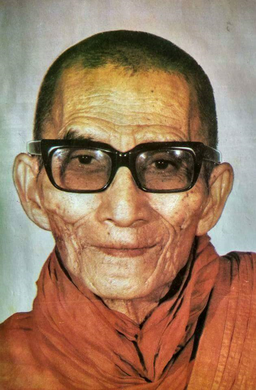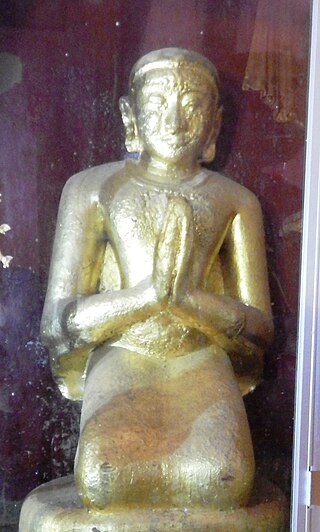Theravāda is the most commonly accepted name of Buddhism's oldest existing school. The school's adherents, termed Theravādins, have preserved their version of Gautama Buddha's teaching or Dhamma in the Pāli Canon for over two millennia.

Anawrahta Minsaw was the founder of the Pagan Empire. Considered the father of the Burmese nation, Anawrahta turned a small principality in the dry zone of Upper Burma into the first Burmese Empire that formed the basis of modern-day Burma (Myanmar). Historically verifiable Burmese history begins with his accession to the Pagan throne in 1044.

Buddhaghoṣa was a 5th-century Sinhalese Theravādin Buddhist commentator, translator, and philosopher. He worked in the great monastery (mahāvihāra) at Anurādhapura, Sri Lanka and saw himself as being part of the Vibhajyavāda school and in the lineage of the Sinhalese mahāvihāra.

Balangoda Ananda Maitreya Thero was a Sri Lankan Buddhist monk who was one of the most distinguished scholars and expositors of Theravada Buddhism in the twentieth century. He was highly respected by Sri Lankan Buddhists, who believed that he had achieved a higher level of spiritual development. Sri Lankan Buddhists also considered Balangoda Ananda Maitreya Thero as a Bodhisattva, who will attain Buddhahood in a future life.

Theravada Buddhism is the largest and official religion of Sri Lanka, practiced by 70.2% of the population as of 2012. Practitioners of Sri Lankan Buddhism can be found amongst the majority Sinhalese population as well as among the minority ethnic groups. Sri Lankan Buddhists share many similarities with Southeast Asian Buddhists, specifically Thai Buddhists and Burmese Buddhists due to traditional and cultural exchange. Sri Lanka is one of only five countries in the world with a Theravada Buddhist majority, and others are Thailand, Cambodia, Laos and Myanmar.
Ari Buddhism or the Ari Gaing is the name given to the religious practice common in Burma prior to Anawrahta's rise and the subsequent conversion of Bagan to Theravada Buddhism in the eleventh century. It was introduced in the 7th century, possibly through trade contact from India or Tibet.

The Visuddhimagga, is the 'great treatise' on Buddhist practice and Theravāda Abhidhamma written by Buddhaghosa approximately in the 5th century in Sri Lanka. It is a manual condensing and systematizing the 5th century understanding and interpretation of the Buddhist path as maintained by the elders of the Mahavihara Monastery in Anuradhapura, Sri Lanka.

The Buddhist flag is a flag designed in the late 19th century as a universal symbol of Buddhism. The flag's six vertical bands represent the five colors of the aura which Buddhists believe emanated from the body of the Buddha when he attained enlightenment.

The nats are god-like spirits venerated in Myanmar and neighbouring countries in conjunction with Buddhism. They are divided between the 37 Great Nats who were given that status by King Anawrahta when he formalized the official list of nats. Most of the 37 Great Nats were human beings who met violent deaths.

Buddhism, specifically Theravāda Buddhism, is the official and state religion of Myanmar since 1961, and practiced by nearly 90% of the population. It is the most religious Buddhist country in terms of the proportion of monks in the population and proportion of income spent on religion. Myanmar has the fourth largest Buddhist population in the world, after China, Thailand and Japan with approximately 48 million Buddhists. Adherents are most likely found among the dominant Bamar people, Shan, Rakhine, Mon, Karen, and Chinese who are well integrated into Burmese society. Monks, collectively known as the sangha (community), are venerated members of Burmese society. Among many ethnic groups in Myanmar, including the Bamar and Shan, Theravada Buddhism is practiced in conjunction with the worship of nats, which are spirits who can intercede in worldly affairs.

Nyanaponika Thera or Nyanaponika Mahathera was a Sri Lankan Theravada Buddhist monk and scholar who, after ordaining in Sri Lanka, later became the co-founder of the Buddhist Publication Society and author of numerous seminal books and articles on Theravada Buddhism. He mentored and taught a whole generation of Western Buddhist leaders such as Bhikkhu Bodhi.
Buddhābhiseka refers to a broad range of Buddhist rituals used to consecrate images of the Buddha and other Buddhist figures, such as bodhisattvas.

The Venerable Mingun Sayadaw U Vicittasārābhivaṃsa was a Burmese Theravāda Buddhist monk, best known for his memory skills and his role in the Sixth Buddhist Council. He was nicknamed The Book Man

Shin Upagutta is an arahant commonly venerated by Buddhists in Myanmar. He is believed to protect worshipers from danger, including floods and storms. He is also venerated in Cambodia, Northern Thailand and Laos, where he is known as Upakhut.

The Venerable Shin Arahan was Thathanabaing of Burma of the Pagan Kingdom from 1056 to 1115. The monk, a native of Thaton Kingdom, was the religious adviser to four Pagan kings from Anawrahta to Alaungsithu. He is credited with converting Anawrahta to Theravada Buddhism, and overseeing the subsequent reformation of the Buddhist school throughout the kingdom. However, evidence strongly suggests that the Theravada Buddhism of Shin Arahan and early Pagan was one strongly influenced by Hinduism as compared to later more orthodox standards. Within 75 years of Shin Arahan's death, the Buddhism of Pagan would be realigned with the Mahavihara school of Ceylon although his Conjeveram-Thaton school lasted 200 more years before finally dying out.

The Sri Lanka Maha Bodhi Centre is a Sri Lankan Buddhist establishment in Chennai, India. It is located in Egmore. It is run by the Sri Lanka Maha Bodhi Society and serves as a monument of friendship between Sri Lanka and India.

Bhante Kumar Kashyap Mahasthavir was a Nepalese Buddhist monk who was awarded the title of Tripitakacharya.
Sri Lankan Forest Monks' Tradition claims a long history. As the oldest Theravada Buddhist country in the world, several forest traditions and lineages have existed, disappeared and re-emerged circularly in Sri Lanka. The current forest traditions and lineages in Sri Lanka have been influenced by the Burmese and Thai traditions which descend from the ancient Indian and Sri Lankan traditions.
The history of Theravāda Buddhism begins in ancient India, where it was one of the early Buddhist schools which arose after the first schism of the Buddhist monastic community. After establishing itself in the Sri Lankan Anuradhapura Kingdom, Theravāda spread throughout mainland Southeast Asia through the efforts of missionary monks and Southeast Asian kings.













